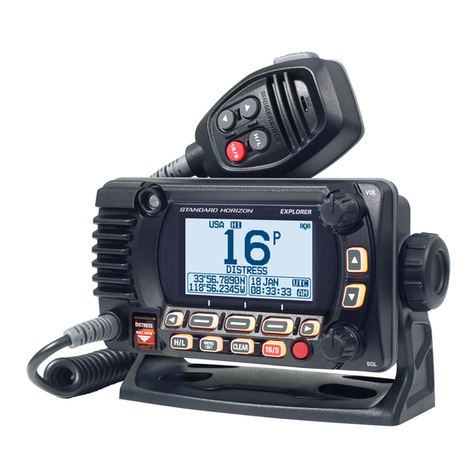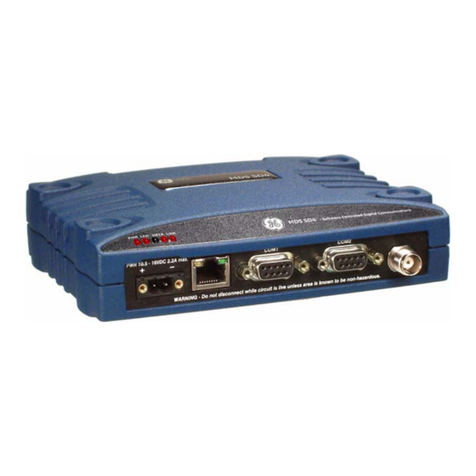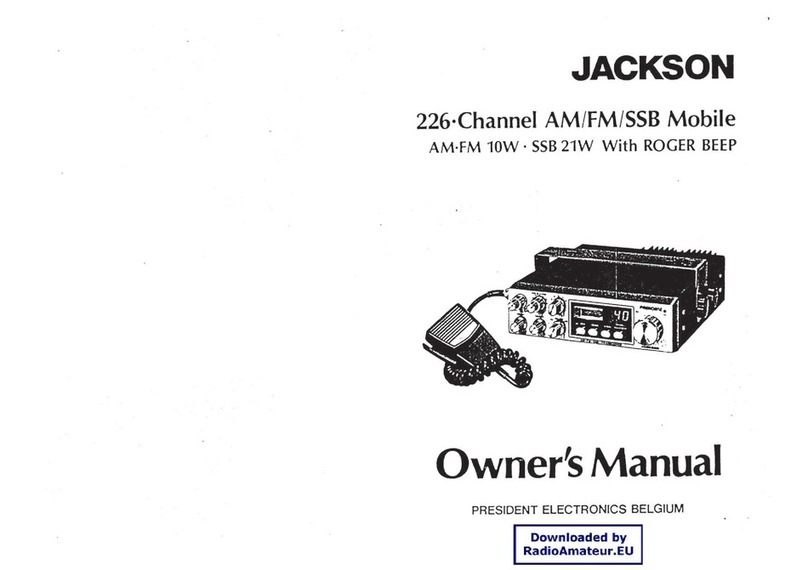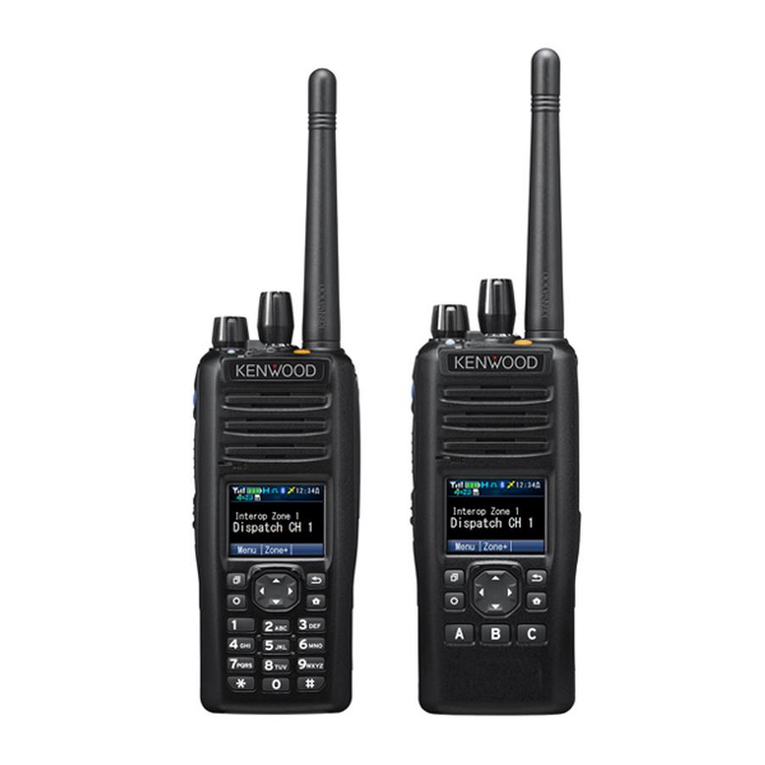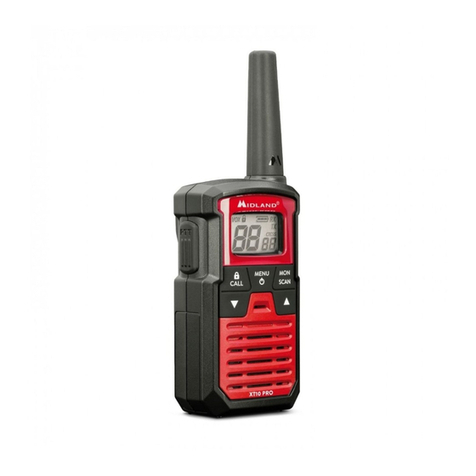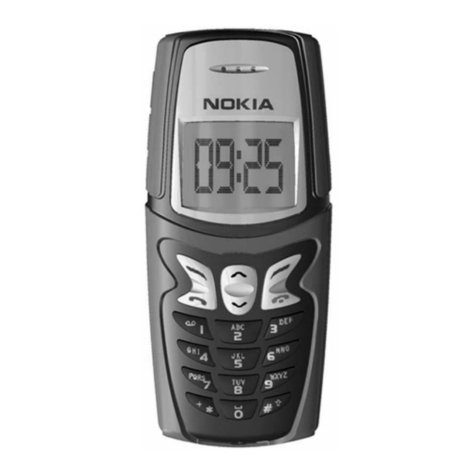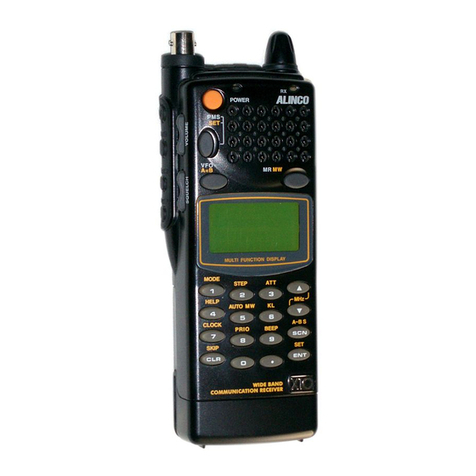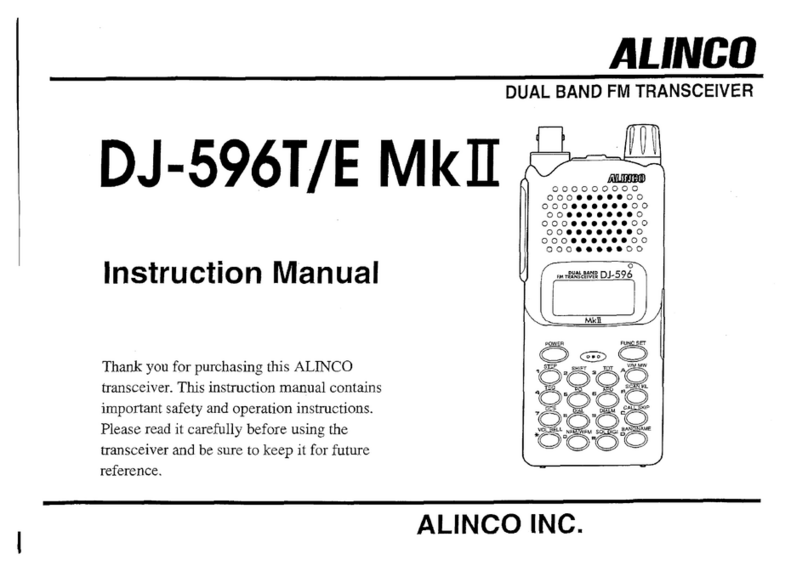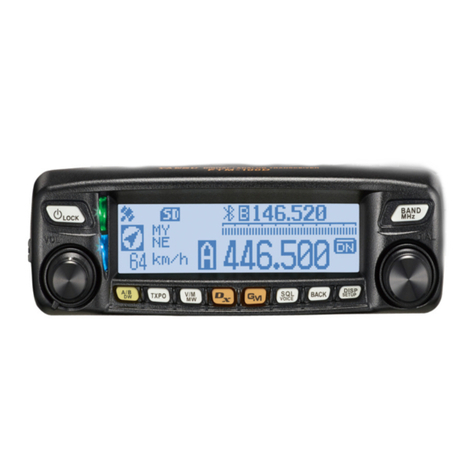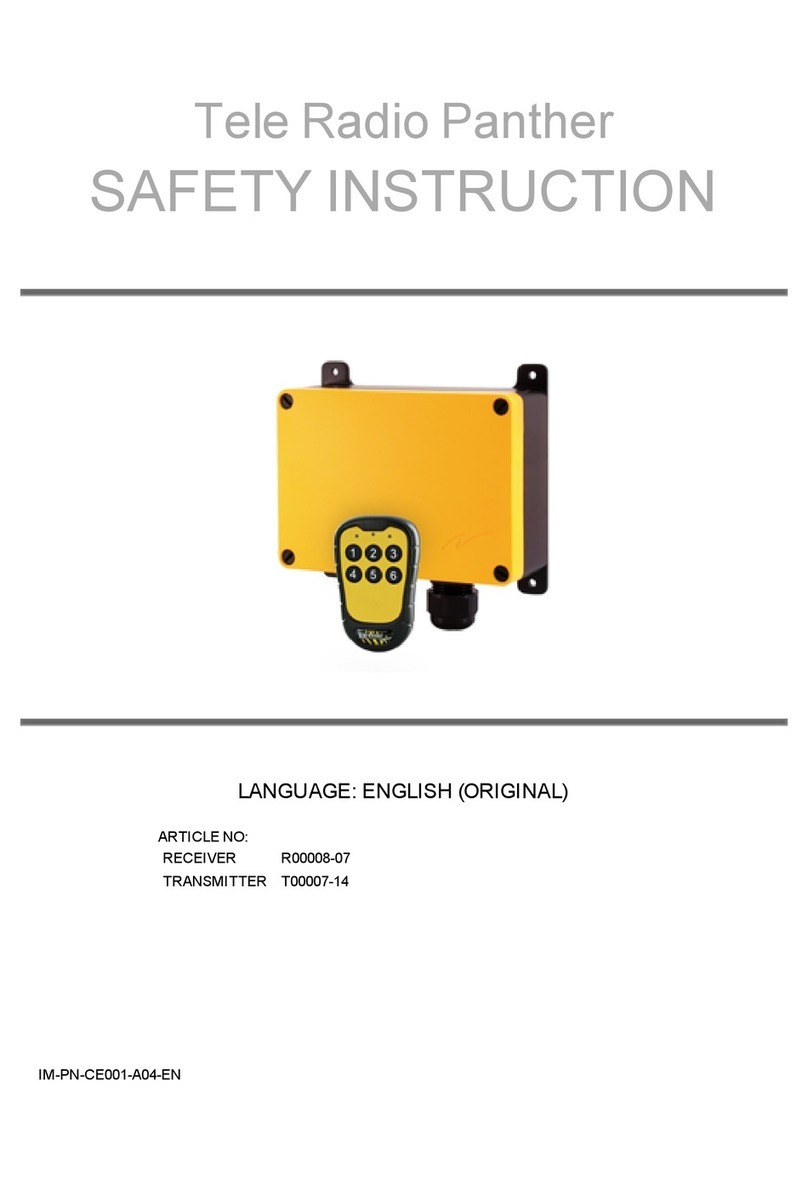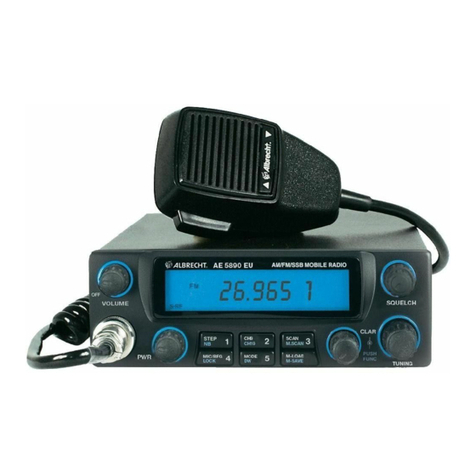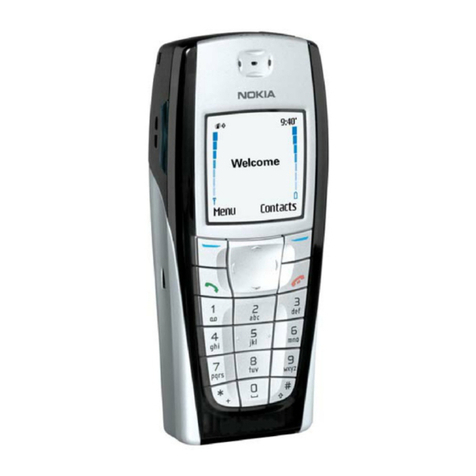Standart Horizon HX320E User manual

HX320E
Floating VHF FM Marine Transceiver
Owner’s Manual

TABLE OF CONTENTS
QUICK REFERENCE ............................................. 1
1. GENERAL INFORMATION ................................ 2
1.1 INTRODUCTION ................................................ 2
2. SAFETY PRECAUTIONS .................................. 3
3. ONLINE WARRANTY REGISTRATION ............ 4
4. ABOUT THIS RADIO ......................................... 4
4.1 ABOUT THE VHF MARINE BAND ..................... 4
4.2 ABOUT WATER PROTECTION ......................... 4
4.3 DISTRESS AND HAILING (CHANNEL 16) ........ 5
4.4 CALLING ANOTHER VESSEL
(CHANNEL 16 OR 9) ........ 5
4.5 BRIDGE CHANNELS 13 AND 67 ....................... 6
4.6 SIMPLEX/DUPLEX CHANNEL USE .................. 6
4.7 NOTES TO ASSURE WATERPROOF
INTEGRITY ......... 7
4.8 RADIO CARE ...................................................... 7
5. ACCESSORIES ................................................. 8
5.1 PACKING LIST .................................................... 8
5.2 OPTIONS ............................................................ 8
6. GETTING STARTED ......................................... 9
6.1 BATTERIES AND CHARGERS .......................... 9
6.1.1 BATTERY SAFETY ..................................... 9
6.1.2 BATTERY CHARGING ............................. 10
6.1.3 BATTERY LIFE INFORMATION ............... 11
6.2 BELT CLIP INSTALLATION / REMOVAL ......... 11
7. CONTROLS AND INDICATORS ..................... 12
7.1 CONTROLS AND SWITCHES ......................... 12
7.2 LCD INDICATORS ............................................ 14
8. BASIC OPERATION ........................................ 16
8.1 PROHIBITED COMMUNICATIONS ................. 16
8.2 INITIAL SETUP ................................................. 16
8.3 RECEPTION ..................................................... 16
8.4 TRANSMISSION ............................................... 16
8.4.1 TRANSMIT POWER ................................. 17
8.4.2 TRANSMIT TIME - OUT TIMER (TOT) ..... 17
8.5 CHANNEL GROUP ........................................... 18
8.6 KEYPAD LOCKING .......................................... 18
8.7 NOAA WEATHER CHANNELS
(In USA and Canada only) ......... 18
8.7.1 NOAA WEATHER ALERT ......................... 19
8.7.2 NOAA WEATHER ALERT TESTING ........ 19
8.8 PRESET CHANNELS: INSTANT ACCESS ...... 20
8.8.1 PROGRAMMING PRESET
CHANNEL BANKS .... 20
8.8.2 OPERATION on a Preset Channel ........... 20
8.8.3 Deleting a Preset Channel ........................ 21
8.9 SCANNING ....................................................... 22
8.9.1 PROGRAMMING SCAN MEMORY .......... 22
8.9.2 SELECTING SCAN TYPE ........................ 22
8.9.3 SCANNING OPERATION ......................... 23
8.10 MULTI WATCH (TO PRIORITY CHANNEL) ... 24
8.10.1 Setting up the Multi Watch Operation ....... 24
8.10.2 Starting the Dual Watch ............................ 24
8.10.3 Starting the Triple Watch........................... 25
8.11 Listening to the FM Broadcast Radio ............... 26
8.11.1 FM broadcast Frequency
sweep operation........... 26
8.11.2 Store the FM frequency............................. 26
8.11.3 Memory Frequency Recall ........................ 27
8.12 Soft Keys .......................................................... 27
8.12.1 Key Assignment ........................................ 27
8.12.2 Key Timer .................................................. 28
9. ADVANCED OPERATION ............................... 29
9.1 Bluetooth
®
Operation ........................................ 29
9.1.1 Pairing the Bluetooth
®
Headset ................. 29
9.1.2 Transmit operation by pressing
the button on the Bluetooth
®
headset ... 31
9.1.3 Hands-free VOX operation
with a Bluetooth
®
headset ... 31
9.1.4 Connect to another paired
Bluetooth
®
headset ... 31
9.2 VOX Operation .................................................. 33
10. MENU (“SETUP”) ......................................... 34
10.1 CHANNEL SETUP ........................................... 34
10.1.1 CHANNEL GROUP................................... 34
10.1.2 WEATHER ALERT (in USA and Canada
only) 34
10.1.3 SCAN MEMORY ....................................... 34
10.1.4 SCAN TYPE.............................................. 34
10.1.5 SCAN RESUME........................................ 35
10.1.6 MULTI WATCH.......................................... 35
10.1.7 PRIORITY CH ........................................... 35
10.1.8 SUB CH..................................................... 36
10.1.9 VOX........................................................... 36
10.2 FM SETUP ....................................................... 36
10.2.1 ADD........................................................... 36
10.2.2 EDIT .......................................................... 37
10.2.3 DELETE .................................................... 37
10.3 BLUETOOTH ................................................... 38
10.4 ATIS SETUP ..................................................... 38
10.5 CONFIG ........................................................... 38
10.5.1 KEY BEEP................................................. 38
10.5.2 BATTERY SAVE........................................ 38
10.5.3 STROBE LED ........................................... 39
10.5.4 KEY SETUP .............................................. 39
10.5.5 BACKLIT LEVEL ....................................... 40
10.5.6 BACKLIT TIMER ....................................... 40
10.5.7 CONTRAST............................................... 40
10.5.8 RESET ...................................................... 41
10.6 ABOUT... .......................................................... 41
10.7 Tables of Setup Menu Operations ................... 41
11. ATIS SETUP .................................................. 43
11.1 ATIS CODE PROGRAMMING ......................... 43
11.2 ATIS CH GROUP ............................................. 44
12. MAINTENANCE ............................................ 45
12.1 GENERAL ........................................................ 45
12.2 FACTORY SERVICE ........................................ 45
12.3 TROUBLESHOOTING CHART ....................... 45
13. VHF MARINE CHANNEL ASSIGNMENTS ... 46
14. SPECIFICATIONS ......................................... 48
STANDARD HORIZON Limited Warranty .......... 49

Page 1
QUICK REFERENCE
PTT (Push-To-Talk): Activates the transmitter when pressed.
SQL: Press to display the SQL level setting screen, then press the [▲] /
[►] key to squelch or press the [▼] / [◄] to un-squelch the radio.
Press and hold to open the squelch. Press the key to resume normal.
Strobe Light: Glows the Strobe Light continuously by pressing the [STRB]
soft key.
MENU/SET:
Press to access MENU. Press and hold to enter SETUP Mode.
VOL− / +VOL: Press to adjust the speaker audio volume.
16/S:
Press to recall channel 16. Press and hold to recall the sub channel.
Soft keys: These three programmable keys can be customized through
the setup menu mode. By pressing one of these keys briey, display the
key functions at the bottom of the display.
MIC: Speak slowly and clearly into the MIC aperture having it about 1/2 to
1 inch (1.2 to 2.5 cm) away from your mouth while pressing the PTT key.
◄/►: Press to toggle the on-screen menus to right/left.
▼/▲: Press to change the operating channel.
CLR/ : Press to cancel a function or menu selection.
Press and hold to lock and unlock the keypad.
: Press and hold to turn the transceiver ON/OFF.

Page 2
1. GENERAL INFORMATION
1.1 INTRODUCTION
Congratulations on your purchase of the HX320E! Whether this is your
first portable marine VHF transceiver, or if you have other STANDARD
HORIZON equipment, the STANDARD HORIZON organization is committed
to ensuring your enjoyment of this high-performance transceiver, which should
provide you with many years of satisfying communications even in the harshest
of environments. STANDARD HORIZON technical support personnel stand
behind every product sold, and we invite you to contact us should you require
technical advice or assistance. We appreciate your purchase of the HX320E,
and encourage you to read this manual thoroughly, so as to learn and fully
understand the capabilities of the HX320E.
The HX320E is a Submersible*1Floating 6-Watt (5-Watt)*2portable two-way
marine transceiver. The transceiver has all allocated International, USA, or
Canadian channels. It has emergency channel 16 which can be immediately
selected from any channel by pressing the [16/S] key. The HX320E is equipped
with the Bluetooth®function as standard, it supports hands-free communications
using the optional Bluetooth®headset or commercially available products.
Connect the USB cable directly to the USB type-C charging terminal of the
HX320E and it will completely charge in about 5 hours.
The HX320E includes the following features: Memory Scanning, Priority
Scanning, Dual and Triple watch, NOAA Weather Alert, easy-to-read large LCD
display, Battery Life display on the LCD, and a transmit Time-Out Timer (TOT).
The HX320E transmitter provides a full 6-Watt (5-Watt)*2of transmit power
which is also to selectable to 1 Watt to assist the user in ensuring maximum
battery life.
The HX320E supports ATIS mode which is used in the inland waterways of
Europe. Please contact your local PTT administration or Marine Authority to
obtain your ATIS number.
We appreciate your purchase of the HX320E, and encourage you to read this
manual thoroughly, so as to learn and fully understand the capabilities of the
HX320E.
*1(IPX7 Specication for submersibility: 3 ft. (1 m) for 30 minutes)
*2(5-Watt TX required in Some Countries)
The Bluetooth®wordmark and logo are registered trademarks owned by Bluetooth
SIG, Inc. and are used under license by Yaesu Musen Co., Ltd.

Page 3
2. SAFETY PRECAUTIONS
Be sure to read the safety precautions, and use this product safely.
Yaesu is not liable for any failures or problems caused by the use or misuse of this product by the purchaser
or any third party. Also, Yaesu is not liable for damages caused through the use of this product by the
purchaser or any third party, except in cases where ordered to pay damages under the laws.
Types and meanings of the marks
DANGER This mark indicates an imminently hazardous situation, which, if not avoided, could result in death
or serious injury.
WARNING This mark indicates a potentially hazardous situation, which, if not avoided, could result in death
or serious injury.
CAUTION This mark indicates a potentially hazardous situation, which, if not avoided, may result in minor or
moderate injury or only property damage.
Types and meanings of symbols
These symbols signify prohibited actions, which must not be done to use this product safely.
For example: indicates that the product should not be disassembled.
These symbols signify required actions, which must be done to use this product safely. For example: indicates
that the power plug should be disconnected.
DANGER
Do not operate the device when flammable gas is
generated.
Doing so may result in fire and explosion.
Do not transmit with this device in a crowded place
for the safety of persons using a medical device
such as a cardiac pacemaker.
The radio wave emitted from this product can cause the
medical device to malfunction and result in an accident.
Do not touch any liquid leaking from the liquid dis-
play with your bare hands.
There is a risk of chemical burns occurring when the
liquid comes into contact with the skin or gets into the
eyes. In this case, seek medical treatment immediately.
Do not touch any material leaking from the battery
pack with bare hands.
The chemical that has stuck to your skin or entered your
eye can cause chemical burns. In such a case, consult
the doctor immediately.
Do not solder or short-circuit the terminals of the
battery pack.
A fire, leak, overheating, explosion, or ignition may result.
Do not carry the battery pack together with a necklace,
hairpin, or small metal objects. A short circuit can result.
WARNING
Do not power this transceiver with a voltage other
than the specified power supply voltage.
A fire, electric shock, or damage may result.
Do not make very long transmissions.
The main body of the transceiver may overheat, result-
ing component failure or operator burns.
Do not disassemble or make any alteration to this product.
An injury, electric shock, or failure may result.
Never touch the antenna during transmission.
This may result in injury, electric shock and equipment failure.
Do not handle the battery pack or charger with wet
hands. Do not insert or remove the power plug with
wet hands.
An injury, leak, fire, or failure may result.
If smoke or a strange odor is emitted from the main
body, battery pack, or battery charger, immediately
turn the transceiver off.
A fire, chemical leak, overheating, component damage,
ignition, or failure may result. Please contact the dealer
from which you purchased this product.
CAUTION
Do not place the transceiver on an unsteady or slop-
ing surface, or in a location with extreme vibration.
The transceiver may fall or drop, resulting in fire, injury
and equipment damage.
Stay as far away from the antenna as possible during
transmission.
Long-term exposure to electromagnetic radiation may
have a negative effect on the human body.
Do not dangle or throw the transceiver by holding
its antenna.
This may injure others and may also result in damage
and failure of the transceiver.
Do not wipe the case using thinner and benzene etc.
Use only a soft, dry cloth to wipe stains from the case.
Keep this product out of the reach of children.
Injury to the child, or damage to the transceiver may result.
Do not use any products other than the specified
options and accessories.
Failure or miss operation may result.
If the transceiver will not be used for an extended
period, turn it OFF for safety.
Do not throw the transceiver, or subject it to strong
impact forces.
Physical abuse may result in component damage and
equipment failure.
Keep magnetic cards and videotapes away from the
transceiver.
The data recorded on cash cards or videotapes may be
erased.
Do not use the transceiver in a crowded place.
The antenna may strike others and result in an injury.
Install the hand strap and belt clip securely.
Improper installation may cause the transceiver to fall or
drop, resulting in an injury or damage.
Before discarding a depleted battery pack, affix tape
or insulating covering to its terminals.

Page 4
3. ONLINE WARRANTY REGISTRATION
Please visit www.standardhorizon.com - Owner’s Corner to register the
HX320E Marine VHF.
NOTE:
visiting the STANDARD HORIZON website from time to time may be bene-
cial. When new products are released, information will appear on the website.
4. ABOUT THIS RADIO
4.1 ABOUT THE VHF MARINE BAND
The radio frequencies used in the VHF marine band lie between 156 and 158
MHz with NOAA Weather stations available between 161 and 163 MHz. The
marine VHF band provides communications over distances that are essentially
“Line of sight” Actual transmission range depends much more on antenna type,
gain and height than on the power output of the transmitter. On a xed mount
25 W radio transmission expected distances can be greater than 15 miles, for
a portable 5 W radio transmission the expected distance can be greater than
5 miles in “Line of sight”.
The user of a Marine VHF radio is subject to severe nes if the radio is used on
land. The reasoning for this is you may be near an inland waterway, or propaga-
tion anomalies may cause your transmission to be heard in a waterway. If this
occurs, depending upon the marine VHF channel on which you are transmitting,
you could interfere with a search and rescue case, or contribute to a collision
between passing ships. For VHF Marine channel assignments refer to section
“13. VHF MARINE CHANNEL ASSIGNMENTS”.
WARNING
This radio is capable of transmitting on Marine VHF radio frequencies.
The FCC allows the use of VHF Marine band on water areas only. Use of
the VHF Marine band when on land is not permitted. If persons use the
VHF Marine Band on land and interfere with other communications, the
FCC will be notied and search for the interference. Responsible parties
found to be transmitting on the VHF Marine Band on land could be ned
up to $10,000 for the rst oense.
4.2 ABOUT WATER PROTECTION
The HX320E is only submersible* when the MIC/SP jack and the CHG jack
are securely covered with the rubber caps.
*(IPX7 Specication for submersibility: 3 ft. (1 m) for 30 minutes)

Page 5
4.3 DISTRESS AND HAILING (CHANNEL 16)
Channel 16 is designated as the Hail and Distress Channel. An emergency may
be dened as a threat to life or property. In such instances, be sure the transceiver
is turned ON, and set to “Channel 16”. Then use the following procedure:
1. Press the PTT (Push-To-Talk) switch and say “Mayday, Mayday, Mayday.
This is _____, _____, _____” (your vessel’s name).
2. Then repeat once: “Mayday, _____” (your vessel’s name).
3. Now report your position in latitude/longitude, or by giving a true or magnetic
bearing (state which) to a well-known landmark such as a navigation aid
or geographic feature such as an island or harbor entry.
4. Explain the nature of your distress (sinking, collision, aground, re, heart
attack, life-threatening injury, etc.).
5. State the kind of assistance you desire (pumps, medical aid, etc.).
6. Report the number of persons aboard and condition of any injured.
7. Estimate the present seaworthiness and condition of your vessel.
8. Give your vessel’s description: length, design (power or sail), color and other
distinguishing marks. The total transmission should not exceed 1 minute.
9. End the message by saying “OVER”. Release the PTT switch and listen.
10. If there is no answer, repeat the above procedure. If there is still no response,
try another channel.
4.4 CALLING ANOTHER VESSEL (CHANNEL 16 OR 9)
Channel 16 may be used for initial contact (hailing) with another vessel.
However, its most important use is for emergency messages. This channel
must be monitored at all times except when actually using another channel.
It is monitored by the U.S. and Canadian Coast Guards and by other vessels.
Use of channel 16 for hailing must be limited to initial contact only. Calling should
not exceed 30 seconds, but may be repeated 3 times at 2-minute intervals. In
areas of heavy radio trac, congestion on channel 16 resulting from its use as
a hailing channel can be reduced signicantly in U.S. waters by using Channel
9 as the initial contact (hailing) channel for non-emergency communications.
Here, also, calling time should not exceed 30 seconds but may be repeated 3
times at 2-minute intervals.
Prior to making contact with another vessel, refer to the channel charts in this
manual, and select an appropriate channel for communications after initial
contact. For example, Channels 68 and 69 of the U.S. VHF Charts are some of
the channels available to non-commercial (recreational) boaters. Monitor your
desired channel in advance to make sure you will not be interrupting other trac,
and then go back to either channel 16 or 9 for your initial contact.

Page 6
When the hailing channel (16 or 9) is clear, state the name of the other vessel
you wish to call and then “this is” followed by the name of your vessel and
your Station License (Call Sign). When the other vessel returns your call, im-
mediately request another channel by saying “go to”, the number of the other
channel, and “over”. Then switch to the new channel. When the new channel
is not busy, call the other vessel.
After a transmission, say “over”, and release the PTT (Push-To-Talk) switch.
When all communication with the other vessel is completed, end the last
transmission by stating your Call Sign and the word “out”. Note that it is not
necessary to state your Call Sign with each transmission, only at the beginning
and end of the contact.
Remember to return to Channel 16 when not using another channel. Some
radios automatically monitor Channel 16 even when set to other channels or
when scanning.
4.5 BRIDGE CHANNELS 13 AND 67
Channel 13 is used at docks, bridges and by vessels maneuvering in port.
Messages on this channel must concern navigation only, such as meeting and
passing in restricted waters.
Channel 67 is used for navigational trac between vessels.
By regulation, power is normally limited to 1 Watt on these channels. Your radio
is programmed to automatically reduce power to this limit on these channels.
However, in certain situations it may be necessary to temporarily use a higher
power. See page 14 for means to temporarily override the low-power limit on
these two channels.
4.6 SIMPLEX/DUPLEX CHANNEL USE
Refer to the section “13. VHF MARINE CHANNEL ASSIGNMENTS” for instruc-
tions on use of simplex and duplex channels.
NOTE
All channels are factory-programmed in accordance with FCC (USA),
ISED (Canada)and International regulations. The mode of operation
cannot be altered from simplex to duplex or vice-versa. Simplex (ship to
ship)or duplex (marine operator)mode is automatically activated, de-
pending on the channel and whether the USA, International or Canadian
operating band is selected.

Page 7
4.7 NOTES TO ASSURE WATERPROOF INTEGRITY
CAUTION!
To ensure the waterproof integrity of the HX320E, please make sure to
observe the precautions described below of the HX320E observe the pre-
cautions regarding waterproong as described below.
Failure to observe even one of the precautions may degrade the water-
proof integrity, resulting in water intrusion into the transceiver. As a result,
the transceiver will not oat.
• To prevent water intrusion please make sure that the MIC/SP cap and CHG
jack cover are properly sealed.
• Make sure that there is no dust, dirt or crack on the jack or the rubber gasket.
NOTE
If you nd any cracks on the MIC/SP cap, CHG jack cover or gasket, please
contact Standard Horizon or your local dealer to purchase a replacement.
4.8 RADIO CARE
After using the HX320E in a salt water environment, it is recommended to
clean the radio with fresh water by rinsing the radio under a sink faucet or by
dunking the radio in a bucket of fresh water. After washing, use a soft cloth and
thoroughly dry all parts of the radio. This is to keep the rubber switches and
speaker grill clean and in top operating condition.

Page 8
5. ACCESSORIES
5.1 PACKING LIST
When the package containing the transceiver is rst opened, please check it
for the following contents:
Transceiver HX320E
Antenna*
USB AC Adapter
Charger Cradle
Belt Clip
USB Cable for charging (USB Type-A to USB Type-C)
Hand Strap
Owner’s Manual
*(Antenna gain: -1.5dBi, Impedance: 50 ohm)
5.2 OPTIONS
Submersible Speaker Microphone with Earphone Jack
SSM-21A
Earphone for SSM-21A SEP-10A
Submersible Speaker Microphone MH-73A4B
Speaker Microphone SSM-17H
VOX Headset SSM-64A
Earpiece Microphone SSM-517A
Bluetooth®Headset SSM-BT10
USB AC Adapter
Quick Release Holster
Belt Clip Hanger
SMA to BNC Adaptor
NOTE: Charge the battery before operating the HX320E for the rst time.
Please see section “6.1 BATTERIES AND CHARGERS” for details.

Page 9
6. GETTING STARTED
6.1 BATTERIES AND CHARGERS
If the radio has never been used, or its charge is depleted, it may be charged
by connecting the supplied USB AC adapter, see section “6.1.2 BATTERY
CHARGING”. The USB AC adapter will charge a completely discharged built-in
battery in approximately 5 hours.
Built-in Rechargeable Battery
Capacity 2100mAh
Nominal Voltage 7.4V
Temperature Range Minimum Maximum
°C °F °C °F
Charge 5 41 35 95
Discharge –20 –4 60 140
Storage –10 14 35 95
CAUTION
To avoid risk of explosion and injury, the built-in battery pack should only
be charged or recharged in non-hazardous environments.
6.1.1 BATTERY SAFETY
The built-in battery of this transceiver contains Li-ion batteries. This type of bat-
tery stores a charge powerful enough to be dangerous if misused or abused,
especially when removed from the transceiver. Please observe the following
precautions:
DO NOT SHORT BATTERY PACK TERMINALS: Shorting the terminals that
power the transceiver can cause sparks, severe overheating, burns, and battery
cell damage. If the short is of sucient duration, it is possible to melt battery
components. Do not place a loose battery pack on or near metal surfaces or
objects such as paper clips, keys, tools, etc.
DO NOT INCINERATE: Do not dispose of any battery in a re or incinerator. The
heat of re may cause battery cells to explode and/or release dangerous gases.
Battery Maintenance
For safe and proper battery use, please observe the following:
Use only STANDARD HORIZON approved batteries.
Do not reverse the charge polarity. Use only the proper charger. If this is
tampered with or another charger is used, permanent damage may result.
Use only a STANDARD HORIZON approved charger. The use of any other
charger may cause permanent damage to the battery.

Page 10
Battery Recycling
DO NOT PLACE USED BATTERIES IN THE REGULAR TRASH!
LI-ION BATTERIES MUST BE COLLECTED, RECYCLED OR
DISPOSED OF IN AN ENVIRONMENTALLY SOUND MANNER.
Incinerating Li-ion batteries, placing them in the land ll, or mixing them with the municipal
solid waste collection, is PROHIBITED BY LAW in most areas.
Return batteries to an approved Li-ion battery recycler. This may be available you
purchased the battery.
Contact your local waste management ocials for other information regarding the en-
vironmentally sound collection, recycling and disposal of Li-ion batteries.
6.1.2 BATTERY CHARGING
Using the supplied USB AC adapter take about 5 hours* to charge the built-in
battery fully.
*(Depending on the battery status, the charging time might be increased.)
1. Turn the transceiver OFF.
2. Referring to the gure, connect the battery charger plugs.
• The HX320E’s LCD display will show the battery charging icon “ ”.
• When charging is completed, the battery charging icon will disappear.
Bottom View
Charger Cradle
USB
AC Ada
pter
USB Charger Cable
CAUTION
The charger and charger cradle are NOT designed to be waterproof.
Do not attempt to charge in water hazardous locations.

Page 11
NOTES
The USB AC adaptor is only designed for the charging of the HX320E’s
built-in battery, and is not suitable for other purposes. The USB AC
adapter may introduce noise to TV and radio reception in the immediate
vicinity, so it is not recommended for use adjacent to such devices.
Contact Standard Horizon dealer or Factory Service about the built-in
battery replacement. Refer to the section “12.2 FACTORY SERVICE”.
6.1.3 BATTERY LIFE INFORMATION
: Full battery power
: Enough battery power
: Low battery power
: Poor battery power. Charge battery.
: Charge the battery immediately
When the “ ” icon appears, it is recommended that the battery be charged soon.
WARNING
If the transceiver will be unused for a long period of time, be sure to
fully charge the built-in battery before storing it. When the transceiver
is stored for an extended period, recharge the built-in battery every six
months to prevent it from over-discharging.
6.2 BELT CLIP INSTALLATION / REMOVAL
rTo install the Belt Clip: align the
Belt Clip to the niche on the rear
of the transceiver, then slide the
Belt Clip downward until it locks
in place with a “Click”.
Strap Hole
rTo remove the Belt Clip: press
the Belt Clip Tab away from the
rear of the transceiver to unlock
the Belt Clip, then slide the Belt
Clip upward to remove it.
Belt Clip Tab

Page 12
7. CONTROLS AND INDICATORS
7.1 CONTROLS AND SWITCHES
NOTE
This section denes each control of the transceiver. For detailed operating
instructions, refer to section “8. BASIC OPERATION”. Refer to the below
illustration for the locations of the following controls, switches, and con-
nections.
ANT Jack
The supplied antenna is attached here.
PTT (PUSH-TO-TALK)Switch
When pushed activates the transmitter.
SQL Switch
Press this key to SQL adjustment.
Secondary use:
Press and hold this key to open the squelch, allowing you to monitor the
operating channel. Press the key to resume normal (squelch controlled)
monitoring.

Page 13
Water Enabled Light
When the HX320E comes in contact with water, the light will blink white to
assist nding the radio in low light conditions. This feature operates when
the radio is ON or OFF.
Keypad
● p(UP) Key
Press this key to change the operating channel or the squelch threshold level.
Pressing the key momentarily, will increase the channel (or level) will increase
one step. Holding the key, will increase the channel (or level) continuously.
● q(DOWN) Key
Press this key to change the operating channel, or the squelch threshold
level.
Pressing the key momentarily, will decrease the channel (or level) will
decrease one step. Holding the key, will decrease the channel (or level)
continuously.
● t& uKeys
Press these keys to select a group of softkeys when the softkeys are
displayed.
● MENU/SET Key
Press to access MENU.
Secondary use:
Press and hold to enter SETUP Mode.
● CLR/ Key
Press to cancel a function or menu selection.
Secondary use:
Press and hold to lock and unlock the keypad.
● VOL- & VOL+ Keys
Press these keys to enable the audio volume adjustment.
● 16/S Key
Pressing this key immediately recalls channel 16 from any channel
selection. Press and hold this key to recall the sub channel.
● POWER Key
Press and hold this key to turn the radio “ON” or “OFF”.
MIC/SP Jack
The jack accepts the optional Speaker/Microphone, VOX Headset, or
Earpiece/Microphone. When this jack is used, the internal speaker and
microphone are disabled.
LCD Display
This display shows current operating conditions, as illustrated the below image.

Page 14
Soft key
These three soft keys can be customized by the Setup Menu mode
described in section “8.12 Soft Keys”. When one of the soft keys is pressed
briey, the functions will appear above each key on the display.
Microphone
The internal microphone is located here.
When transmitting, position the microphone about 1/2 to 1 inch (1.2 ~ 2.5
cm) away from your mouth. Speak slowly and clearly into the microphone.
CHG Jack
The jack accepts the supplied Type-C USB charger cable.
Speaker
The internal speaker is located here.
7.2 LCD INDICATORS
①② ⑥⑤ ⑦ ⑧
⑨
③
④
⑫
⑬
⑭
⑩
⑪
“ ” Indicator
This indicator appears during transmission.
“ ” Indicator
This indicator appears when a signal is being received or the radio is un-
squelched.
Channel Group Indicator
These indicators show the selected channel group.
“USA”: USA, “INTL”: International, “CAN”: Canada,
“UK”: United Kingdom (U.K.), “BE”: Belgium, “NL”: Netherlands,
“SW”: Sweden, “GE”: German, “NO”: Norway
“DW” Indicator
DW: Dual Watch is activated.
TW: Tri-Watch is activated.

Page 15
TRANSMIT POWER Indicator
“HI”: 6 W (5 W)*
“MD”: 2.5 W
“LO”: 1 W
*(5 W TX required in some countries)
“MEM” Indicator
This indicator shows the channel is registered in the transceiver “Scan Memory”.
“P-SET” Indicator
Shown when the channel is programmed into the Preset Channel memory.
Battery Indicator
: Full battery power
: Enough battery power
: Low battery power
: Poor battery power. Charge battery.
: Charge the battery immediately
“ ” Bluetooth Indicator
Shown
when the Bluetooth®function is activated.
Appears: Bluetooth®device is connected.
Blinks: Bluetooth®device not connected.
“ ” VOX Indicator
S
hown when the VOX (Voice operated transmission) function is enabled.
“P” Indicator
Shown when the channel is set as the Priority Channel.
“D” Indicator
S
hown when the Dual Watch function is enabled in FM radio mode.
“T” Indicator
S
hown when the Triple Watch function is enabled in FM radio mode.
Channel Display
The operating channel is shown on the LCD in both the transmit and the
receive modes.
VOL Indicator
This indicator shows the receive audio volume level.
SQL Indicator
This indicator shows the squelch setting level.

Page 16
8. BASIC OPERATION
8.1 PROHIBITED COMMUNICATIONS
The FCC prohibits the following communications:
False distress or emergency messages.
Messages to “any boat” except in emergencies and radio tests.
Messages to or from a vessel on land.
Transmission while on land.
Obscene, indecent, or profane language (potential ne of $10,000).
8.2 INITIAL SETUP
1. To install the antenna onto the transceiver; hold the bottom end of the
antenna, then screw it onto the mating connector on the transceiver until
it is snug. Do not over-tighten.
8.3 RECEPTION
1. Press and hold the POWER key for one second to turn the radio “ON”.
2. Press and hold the [SQL] switch until the
“” indicator appears on the display. This
is the “squelch o” state.
2. Press the [VOL-] or [VOL+] key until noise
or audio from the speaker is heard at a
comfortable level.
3. Press the [SQL] switch to resume normal (quiet) monitoring.
5. Press the [p] or [q] key to select the desired channel. Refer to the channel
chart on page 46 for available channels.
6. When a signal is received, adjust the volume to the desired listening level.
The “ ” indicator on the LCD is displayed indicating that the channel
is being used or the radio is not squelched.
8.4 TRANSMISSION
1. Setup the transceiver as described in the “8.3 RECEPTION” discussion
above.
2. Before transmitting, monitor the channel and make sure it is clear.
THIS IS AN FCC REQUIREMENT!
3. Press the PTT (Push-To-Talk) switch to
transmit. During transmission, the “ ”
indicator will appear on the display.
4. Position the microphone about 1/2 to 1 inch (1.2 ~ 2.5 cm) away from your
mouth. Speak slowly and clearly into the microphone.
5. When the transmission is nished, release the PTT switch.

Page 17
8.4.1 TRANSMIT POWER
The TX output power of the HX320E is set to high level (6 W※) in factory default,
and the “HI” indicator is displayed on the top part of the screen.
To change the TX output power:
1. Press one of the soft keys.
2. Press the [◄] or [►] key repeatedly, until [HI],
[MD], or [LO] is displayed above a soft key at
the bottom of the LCD.
3. Press the [HI], [MD], or [LO] soft key to switch
between HI (6 W (5 W)*), MD (2.5 W), or
LO (1 W) output power.
*(5 W TX required in Some Countries)
8.4.2 TRANSMIT TIME - OUT TIMER (TOT)
While the PTT switch is held down, transmission time is limited to 5 minutes.
This prevents prolonged (unintentional) transmissions. About 10 seconds before
automatic transmitter shutdown, a warning beep will sound from the speaker.
The transceiver automatically switches to receive mode, even if the PTT switch
continues to be held down. The PTT switch must rst be released, then wait
10 seconds before transmission may be started again. This Time-Out-Timer
(TOT) prevents a continuous transmission that would result from an accidentally
stuck PTT switch.
WATER ENABLED LIGHT
When the HX320E comes in contact with water a white light will blink to
assist retrieving it in low light conditions. The light will automatically turn
o in about 15 seconds when it is removed from water.
The HX320E has a menu selection to enable and disable. Refer to SET-
UP Mode Item “STROBE LED (Water Hazard)” on page 39 for details.

Page 18
8.5 CHANNEL GROUP
Set the Channel Group according to the region.
1. Press and hold the [MENU/SET] key.
2. Press the [▲] or [▼] key to select “CHANNEL SETUP”.
3. Press the [SELECT] soft key.
4. Press the [▲] or [▼] key to select “CHANNEL GROUP”.
5. Press the [SELECT] soft key.
6. Press the [▲] or [▼] key to select the desired
channel group “INTERNATIONAL”, “USA”, or
“CANADA”*.
*(In the European version, when setting the
region, the selected European Channel Group
will be displayed instead of “CANADA”. For
details, refer to the Note on the Setting the
Region on the separate yellow insert sheet.)
7. Press the [ENTER] soft key to store the selected setting.
8. Press the [CLR/ ] key to return to radio operation.
8.6 KEYPAD LOCKING
In order to prevent accidental channel change, the HX320E’s keypad may be
locked.
Hold down the [CLR/] key to lock the keypad (except the PTT, [VOL-],
[VOL+] and [CLR/] keys) so that they are not accidentally changed. “KEY
LOCK” will appear on the entire screen, to indicate that the functions are locked.
To unlock the keys, press and hold the [CLR/ ] key until “UNLOCK” appears.
8.7 NOAA WEATHER CHANNELS (In USA and Canada only)
1. Press the [MENU/SET] key to display the
MENU screen, then press the [WX] soft key.
The transceiver changes to the weather
channel mode and the radio will be set to the
last used NOAA weather channel.
2. Press the [▲] or [▼] key to select a dierent
NOAA weather channel.
3.
To exit from the NOAA weather channels, press the [MENU/SET] key to
display MENU screen, then press the [CH] soft key. The transceiver will
revert to the channel in use prior to switching to the weather channel mode.
Table of contents
Other Standart Horizon Transceiver manuals


